The subtleties of growing zinnia

Zinnia is an ornamental plant that is popular with flower growers. It is distinguished by its varietal variety, unpretentious care and rapid growth. Despite this, in order to get a strong and beautiful flower, you need to know the basic subtleties of its cultivation.
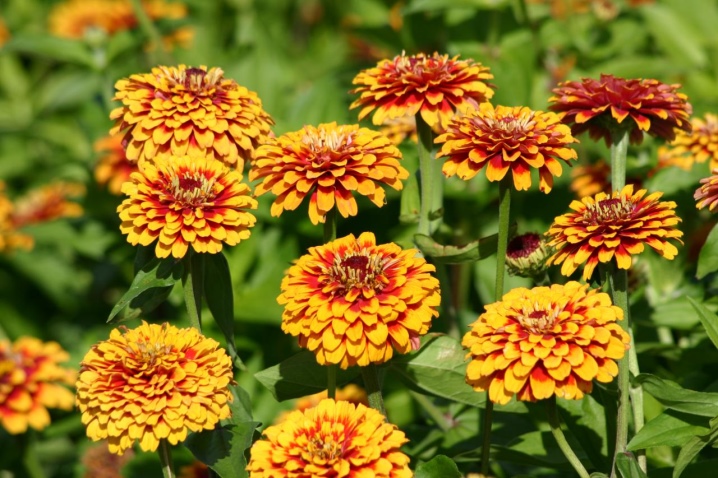
Description
Zinnia belongs to the genus of herbaceous and shrubby compositae annuals of the Aster family, numbering about 22 varieties. Southern Mexico is considered the birthplace of the flower, and it owes its name to Johann Gottfried Zinn. The people call this plant a major. In some countries, the flower is cultivated as a perennial.
Depending on the region, the plant can be dwarf undersized, medium and tall. Therefore, its height can vary from 20 to 100 cm. Its vertical stems are covered with short hairs. As it grows on both sides of the shoots, rough, heart-shaped leaves with hard pubescence are formed. At the ends, the leaves are pointed.


The stems of zinnia are powerful, branched and herbaceous, the inflorescences are single, representing the apical baskets. Peduncles are usually long, flowers in diameter reach from 3 to 15 cm.
The buds of the plant are lush, the petals are located one above the other. Shades of colors can be very diverse (except for blue). After flowering, zinnia dies, the plant is afraid of frost.

Optimal disembarkation time
The flowering period of zinnia lasts from mid-July until frost. Both annuals and perennials reproduce generatively. Planting in open ground is usually started in May, when there are no more night frosts. If the seeds are planted earlier, they will simply die.
Experienced flower growers plant zinnia seedlings with preliminary hardening. Then rooting is more successful. In order to have time to plant seedlings in May, they start sowing seeds in April, preparing the soil and containers in advance.
Before the second half of April, planting seeds is impractical - the stems grow quickly. During transportation to the place of disembarkation, they may break. In addition, overgrown seedlings take root worse and get sick more often.
If the climate in the region is cold, the plant can be planted until early June. At the same time, germinated seeds are planted in 2-3 pieces in order to avoid further picking. You can plant zinnia before winter.


How to grow seedlings?
To find out which seeds are suitable for sowing, they are wrapped in damp gauze soaked in Epin. Fresh seeds will germinate in 2 days, while old seeds will take at least a week to germinate.
Sowing seeds
It is better to sow seeds in separate containers. For these purposes, you can use plastic cups, cassettes, seed containers or peat tablets. Self-made containers are also suitable as containers for seedlings (for example, glasses from boxes of milk, kefir, juices, cut plastic bottles). Ideally, a container with a capacity of 200-250 ml is needed for planting.
Drainage holes must be made in each container (except for peat tablets). If this is not done, the soil may acidify. In such conditions, the roots rot quickly. When boxes are used for disembarkation, they try to prepare wide containers. The optimal drawer height should be 10 cm.


Zinnia prefers nutritious and loose soil.To make it grow quickly, you can plant it in a special soil purchased from a store. If the soil is prepared at home, perlite, vermiculite or sand must be added to it. The composition of the soil usually includes:
- sod land (2 parts);
- garden soil (1 part);
- peat (1 part);
- sand (1 part).
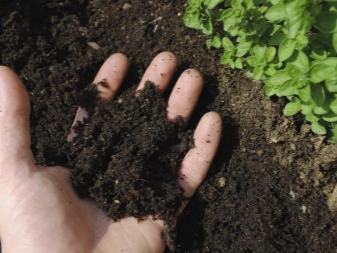


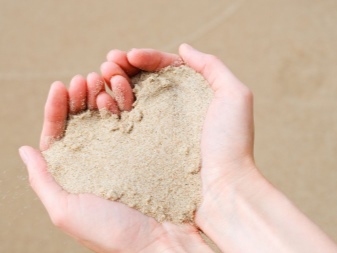
If there is no turf, it can be replaced with humus or compost (in a smaller amount). Before planting, the seeds are soaked in a growth stimulator. Due to this, the seedlings will be stronger and more resilient. Plant seeds like this:
- a drainage layer is placed on the bottom of the container - 2 cm;
- the containers are filled with soil, leaving 2 cm from the edge;
- moisten the earth using a spray bottle;
- make a hole in the center with a depth of 3-5 mm;
- 2-3 seeds are planted in the hole, covered with earth on top;
- watering the planted seeds.
After that, the containers are covered with plastic wrap or glass and removed for germination. Old seeds (those that take a long time to sprout) can be disposed of. Germinated - planted seed down, sprout up.



How to care for seedlings?
In general, zinnia is considered an unpretentious flower to care for. The optimum temperature for germination is from +23 to +25 degrees Celsius. After friendly shoots appear, the temperature must be lowered to + 18 ... 20 degrees. Within 2-3 days, it is necessary to ventilate the ground.
When the seeds germinate, the film is removed, the containers are placed in a more illuminated place (for example, on a table near a window or a windowsill). With a lack of light, the plant will stretch in length. If this happens, you need to add earth. Do not place seedlings in direct sunlight. The light should be diffused.
Water the seedlings moderately and regularly. Do not allow the soil to dry out. It is necessary to moisten the soil with settled water at room temperature. Tempering begins in late May. Seedlings are taken out onto the balcony about 2 weeks before planting in open ground.

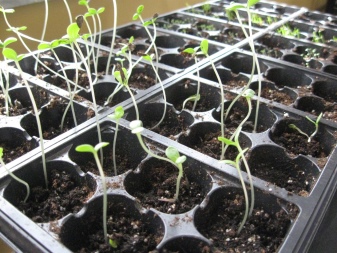
After the soil has warmed up, you can start transplanting to a permanent place. Seedlings in containers are spilled with warm water. This will make it easy to separate the branchy roots from each other. The disembarkation is carried out in a well-lit place, sheltered from drafts.
The soil requirements are optimal: it must be nutritious, moderately neutral and well-drained. If necessary, it is acidified, mixed with sand and peat, and fed with mineral fertilizers. They prepare the soil in the fall, digging it to a depth of 40-45 cm.
The planting is carried out to a depth of 10 cm with a distance between the holes of 35-40 cm. The roots must be handled as carefully as possible - they are easily injured. To facilitate adaptation in a new place, the seedlings are transplanted by the transfer method. It can be planted directly in peat tablets or cups.


After the plant is placed in the hole, add earth and squeeze the stem with it. It remains to spill the seedlings with water. To make it easier for zinnia to take root in a new place, you need to choose the right watering conditions. It is preferable to do this in the evening, when direct sunlight does not fall on the plant.
Containers for seedlings must be selected in the optimal size. They dry quickly in small cups. If the plant is grown in peat glasses or tablets, they can be placed in a container with moist rotted sawdust. With this cultivation, you need to moisten both seedlings and sawdust. You can even water only sawdust.

Landing in open ground
You can plant seeds in the country and immediately into the open ground, choosing a place on the hill of the summer cottage. They need to be sown to a depth of no more than 5-9 mm. The distance between the holes should be sufficient, you can make grooves - this makes it easier to plant the seed. The seeds are laid out on the ground, after which they are sprinkled with dry soil or peat.
Then the soil is sprayed with warm water from a spray bottle. After that, the plantings are covered with a film, creating greenhouse conditions for germination.Zinnias, seeded outdoors, usually flower 2 weeks later than seedlings. However, they themselves are much stronger and healthier.
When planting zinnia, you need to take into account aesthetic nuances. For example, undersized varieties look beautiful in small flower beds. For tall flowers, group plantings are preferable. Dwarf varieties are best grown at home. However, they can also be planted as ground cover plants.


Correct care
Caring for zinnias is no more difficult than for other flowers, moreover, they can be grown both at home and immediately on a personal plot. But if the care is not timely, you should not count on lush flowering.
Watering
There is no rigid framework for watering, since it all depends on the amount and frequency of precipitation. Zinnia does not like excessive watering - this leads to its diseases, root rot and death. You need to water the flower sparingly, but in sufficient volume, directing the water stream under the root. Watering the buds is undesirable.
Although the plant can tolerate drought, the soil should not be allowed to dry out. This leads to wilting of leaves and weakness of the shoots. In addition, the rarity of watering is reflected in the shade of the flowers: with a lack of moisture, they become faded.

Loosening and mulching
Despite the fact that the roots of zinnia are delicate, loosening is a must and regular point of care. In addition, for normal growth and development, it is necessary to rid the soil of weeds. Its roots take up nutrients, and therefore the flower may be deficient.
Weed and loosen the soil near the roots as carefully as possible. We must not forget about mulching. It will reduce the frequency of loosening and weeding. Adding dry peat around the stalks will reduce the growth of weeds, which usually have to be dealt with constantly.


Top dressing
Timely fertilization of zinnia allows you to achieve the most lush and abundant flowering. You need to feed the plant during the period of its active growth and development. Feeding begins with feeding the seedlings. Until the moment of its landing in a permanent place, it is fertilized twice.
At this time, it is better to feed the seedlings with mineral complexes with a minimum nitrogen content. Before flowering, it is allowed to feed the zinnia 2 more times. The first time it is better to do this about a month after disembarking to a permanent place. For this, you can use both diluted manure and special complex fertilizers. You can fertilize the flower a second time during the budding period.


Pinching
Pinching is performed in order to obtain a more lush bush. It promotes the growth of lateral shoots and the formation of shoots. Usually, flower growers do this when growing seedlings. The ideal time for pinching is the period when the plant has a true 5th leaf.
You can form a bush after the seedlings take root in a permanent place in the open field. Tall varieties intended for cutting do not need to be pinched.
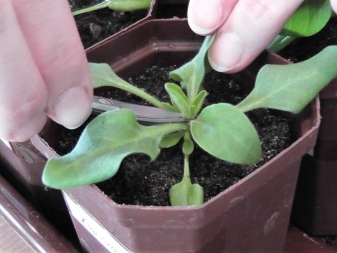

Post-flowering period
Further care of the plant will consist in collecting seed and preparing for wintering.
Seed collection
Seed collection is started after the end of the flowering period. Usually seeds ripen 2 months from the beginning of flowering. Florists mark the inflorescences in advance, from which they will later collect seeds. For this, flowers that bloom first are suitable.
It is the shoots of the first order that will give better quality seed in the future. Mature baskets are dark brownish. They are cut from the bush and dried, after which they are husked and stored in an optimally warm and dry place. It is important to locate them in a room with a constant climate and the same temperature. Seed germination lasts for 3-4 years.


Wintering
Those plants that are grown in pots, with the onset of autumn, are brought into the house and looked after, like an ordinary indoor flower. It is necessary to ensure that the temperature at the location is approximately the same. It is undesirable to put zinnia on a windowsill, where it constantly blows due to poor glazing. If the bottom of the window sill warms up from the radiator, and cold air flows to the side of the flower, the plant will get sick.


Features of growing at home
You can also grow zinnia at home. It is better to buy seed for this in agricultural firms or specialized points of sale. You can purchase ready-made seedlings, giving preference to single-planted shoots. You need to choose those plants that have strong stems and low height.
Caring for such a flower does not differ from other indoor plants. The main rules of care will be timely watering, ensuring a sufficient amount of light, loosening, mulching and feeding. There is no need to water the flowers "for company". If the top layer is wet, no watering is needed.
You need to monitor the health of the flower regularly.
This will allow you to identify the cause of the disease early and eliminate the problem without waiting for it to touch other indoor plants. If the soil is damp, the plant will rot. Do not allow the leaves to turn brown - it is worth reconsidering the care.

Diseases and pests
The plant is sick mainly due to improper care or its complete absence. In addition, an improper landing can also be the cause of the disease. You can not bury the seedlings and waterlogging them.
As for pests, more often the plant is attacked by may beetles, slugs and aphids. Prevention in these cases is the installation of small containers with beer on the site. It attracts insects. May beetles are disposed of by hand by collecting them from the plant and placing them in a soapy solution.



If the plant is affected by aphids, it is treated with a solution of tar soap with water. If the lesion is large, buy a special drug "Fufanon". When zinnia gets hit powdery mildew, gray mold, bacterial spot and fusarium, get rid of all the affected parts of the plant.
The main causes of these diseases are thickening and over-watering. If the scale of the problem is large, the flower has to be destroyed completely. In other cases, fungicides are used for treatment. To rid the flower of powdery mildew you can use "Topaz", "Speed", "Topsin".




For the cultivation and care of zinnia, see the next video.



































































































The comment was sent successfully.